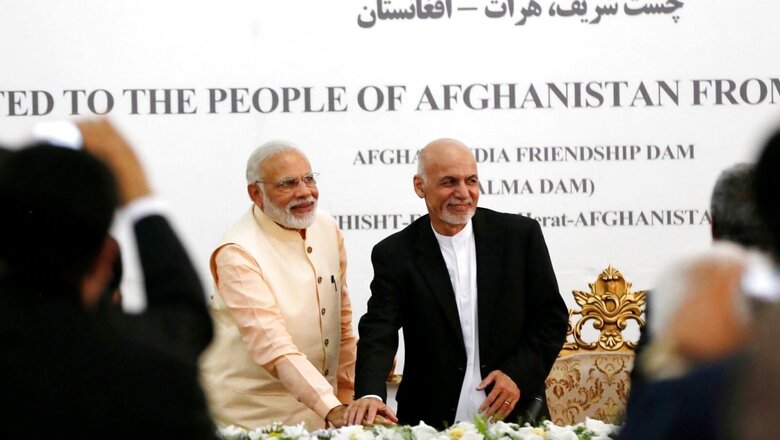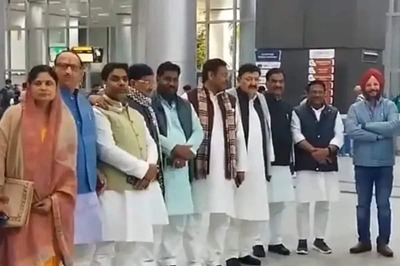
views
After nearly two decades of restoring a centuries-old connection, India now faces the future of not having any involvement in Afghanistan, and even having no diplomatic presence, as Taliban fighters inched closer to the capital after routing the country’s defences over the past week. CNN-News18 had earlier reported that Indian embassy staff in Kabul will be evacuated as the crisis on the ground at the capital worsens.
Critical to India’s regional strategic interests, it is also the only SAARC country where the citizens have strong affection for India.
Following a break between 1996 and 2001, when India joined the rest of the world in shunning the previous Taliban regime (only Pakistan, the United Arab Emirates, and Saudi Arabia maintained ties), one way New Delhi re-established ties with the country in the two decades following the 9/11 attacks, was to pour in development aid under the auspices of the UN.
ALSO READ | India May Offer Asylum to Indian Supporters in Afghanistan Fleeing the Violence: Sources
MEA on Evacuation, Projects
The Ministry of External Affairs (MEA) on Thursday expressed concerns about the deteriorating situation in Afghanistan and said that there will be an immediate and comprehensive ceasefire. MEA spokesperson Arindam Bagchi said in a briefing that Indians in Afghanistan have been asked to return through commercial flights. “We will ensure all necessary assistance to Hindus and Sikhs,” said Bagchi on helping minorities. However, he said that there is no formal evacuation mechanism.
External Affairs Minister S Jaishankar, speaking at the Afghanistan Conference in Geneva in November 2020, said “no part of Afghanistan today is untouched by the 400-plus projects that India has undertaken in all 34 of Afghanistan’s provinces”. What will happen to these projects now remains to be seen.
Critical Infrastructure
India constructed critical infrastructure such as highways, dams, energy transmission lines and substations, schools and hospitals, and so on. The value of India’s development support has risen to well over $3 billion. And, unlike in other places where India’s infrastructure projects have stalled or become entangled in the politics of the host country, it has delivered in Afghanistan.
ALSO READ: Not Taliban, India’s Regional Security Challenges Come from Pakistan-China Nexus
The 2011 India-Afghanistan Strategic Partnership Agreement recommitted Indian assistance to help Afghanistan rebuild its infrastructure and institutions, as well as provide education and technical assistance for capacity-building in a variety of areas, encourage investment in Afghanistan, and provide duty-free access to the Indian market. The value of bilateral trade has risen to $1 billion.
Salma Dam
There has already been fighting in the area where one of India’s high-profile projects, the 42MW Salma Dam in Herat province, is located. The Afghan-India Friendship Dam is a hydroelectric and irrigation project that was built despite all obstacles and launched in 2016. The Taliban have launched attacks in nearby areas in recent weeks, killing several security officers. The Taliban claim to have taken control of the area surrounding the dam.
Taliban Seize Helicopters Donated by India
The Taliban has reportedly seized one of the four attack helicopters donated by India to Afghanistan in 2019, after they overpowered the airport in Kunduz, which is located in the northern province. The Taliban were seen on social media posing next to an Mi-24 attack helicopter, the livemint reported. India had gifted the four Mi-24V attack choppers to the Afghan Air Force along with three Cheetah Light Utility Helicopters. The attack helicopters were reportedly given as part of an agreement between Afghanistan and Belarus, which was financed by New Delhi.
ALSO READ: Afghanistan President Ashraf Ghani’s Pakistan Gambit Was Based on 3 Promises and None Were Kept
Zaranj-Delaram Motorway
The Border Roads Organisation’s 218-kilometer Zaranj-Delaram highway was another high-profile project. Zaranj is near to the Iranian border in Afghanistan. The $150 million highway follows the Khash Rud River to Delaram, northeast of Zaranj, where it joins a ring road that connects Kandahar in the south, Ghazni and Kabul in the east, Mazar-i-Sharif in the north, and Herat in the west.
Afghan Parliament
India spent $90 million to construct the Afghan Parliament in Kabul. The structure was inaugurated by Prime Minister Narendra Modi in 2015. Modi presented the structure as India’s gift to Afghanistan’s democracy in a lengthy address in which he quoted Rumi, who was born in Balkh, Afghanistan, and the timeless Yaari hai imaan mera yaar meri zindagi from Zanjeer, which starred Pran in the role of Sher Khan, the Pathan. Former Prime Minister AB Vajpayee has a block in the structure named after him.
Stop Palace
In 2016, Afghan President Ashraf Ghani and Prime Minister Modi reopened the rebuilt Stor Palace in Kabul, which was originally erected in the late 1800s and served as the site of the 1919 Rawalpindi Agreement, which led to Afghanistan’s independence. Until 1965, the building hosted the Afghan foreign minister’s and ministry’s offices. A tripartite agreement for its restoration was reached in 2009 by India, Afghanistan, and the Aga Khan Development Network. Between 2013 and 2016, the Aga Khan Trust for Culture finished the project.
Power Infra
Other Indian projects in Afghanistan include the rebuilding of power infrastructure, such as the 220kV DC transmission line from Pul-e-Khumri, the capital of Baghlan province, to Kabul, to increase electricity supplies. Telecommunications infrastructure was also restored in various areas by Indian contractors and personnel.
Healthcare
India has reconstructed a children’s hospital in Kabul that it helped establish in 1972 and renamed the Indira Gandhi Institute for Child Health in 1985 after the conflict. Free consultation camps have been hosted by ‘Indian Medical Missions’ in a number of locations. The Jaipur Foot has been fitted to thousands of people who have lost limbs after walking on mines left behind from the war. Badakhshan, Balkh, Kandahar, Khost, Kunar, Nangarhar, Nimruz, Nooristan, Paktia, and Paktika are among the border provinces where India has developed clinics.
Transportation
India gave 400 buses and 200 minibuses for urban transit, 105 utility vehicles for municipalities, 285 military vehicles for the Afghan National Army, and 10 ambulances for public hospitals in five cities, according to the MEA. When Ariana, the Afghan national carrier, was resuming operations, it received three Air India aircraft.
Read all the Latest News, Breaking News and Special: Live-updating IPL 2022 auction tally | IPL Mega Auction Live Updates here.




















Comments
0 comment